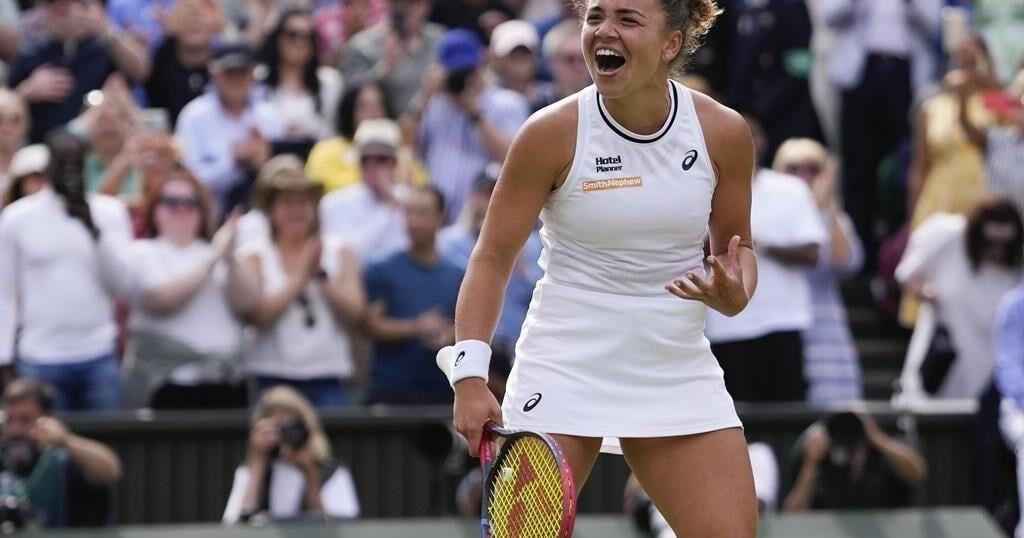LONDON (AP) — Barbora Krejcikova kept insisting that nobody — not her friends, not her family, not even herself — would believe she won Wimbledon for her second Grand Slam title.
Her first major championship, as an unseeded player at the French Open three years ago, certainly was a surprise. This one, which came via a 6-2, 2-6, 6-4 victory over Jasmine Paolini in the final at the All England Club on Saturday, was maybe just as unpredictable, sure, but perhaps now it’s time to recognize that these sorts of results from Krejcikova are not only possible but make perfect sense.
“It’s just unreal what just happened. Definitely the best day of my tennis career — and also the best day of my life,” said Krejcikova, a 28-year-old from the Czech Republic, who thanked her late mentor, 1998 Wimbledon champion Jana Novotna, for pushing her into professional tennis.
Even while holding her gold champion’s plate, Krejcikova described herself as “the lucky one” for getting past the seventh-seeded Paolini, who also was the runner-up at the French Open last month.
Krejcikova was only the 31st of 32 seeds at the All England Club after illness and a back injury this season limited her to a 7-9 record entering this tournament. Then came a three-setter in the first round last week, adding to the doubts.
But by the end of the fortnight, there Paolini was during the trophy ceremony, telling Krejcikova: “You play such beautiful tennis.”
Krejcikova is the eighth woman to leave Wimbledon as the champion in the past eight editions of the event. Last year’s champion also is from the Czech Republic: unseeded Marketa Vondrousova, who lost in the first round last week.
Paolini is the first woman since Serena Williams in 2016 to get to the finals at Roland Garros and Wimbledon in the same season — and the first since Venus Williams in 2002 to lose both.
Saturday’s finalists took turns being in charge.
Playing coolly and efficiently — seemingly effortlessly — Krejcikova claimed 10 of the first 11 points and quickly owned a double-break lead at 5-1.
As much as the crowd, likely because of a desire to see a more competitive contest, pulled loudly for Paolini, yelling “Forza!” (“Let’s go!”) the way she often does, or “Calma!” (“Be calm!”), Krejcikova never wavered.
She has net skills, to be sure — that’s part of why she has won seven Grand Slam women’s doubles titles, including two at Wimbledon — but Krejcikova mainly was content to stay back at the baseline, simply delivering one smooth groundstroke after another to its appointed spot and getting the better of the lengthiest exchanges.
There really was no need for anything other than Plan A in the early going in front of a Centre Court crowd that included actors Tom Cruise, Kate Beckinsale and Hugh Jackman.
Paolini did try to shake things up a bit, with the occasional serve-and-volley rush forward or drop shot, but she couldn’t solve Krejcikova. Not yet, anyway.
After the lopsided first set, Paolini went to the locker room. She emerged a different player, one who no longer looked like someone burdened by residual fatigue from the longest women’s semifinal in Wimbledon history, her 2-hour, 51-minute win over Donna Vekic on Thursday.
Paolini had come back from dropping the first set in that one, so she knew she had it in her. And she began the second set against Krejcikova in style, using deep groundstrokes to grab a 3-0 advantage.
Once the match was tied at a set apiece, it was Krejcikova who left the court to try to recalibrate.
Her shots that suddenly went so awry in the match’s middle — after just four winners in the second set, she accumulated 14 in the third — were back to being crisp and clean.
“I was just telling myself to be brave,” Krejcikova said.
At 3-all in the deciding set, it was Paolini who faltered, double-faulting for the only time all afternoon to get broken.
Krejcikova then held at love for 5-3, but when she served for the championship, things got a little tougher.
She needed to save a pair of break points and required three match points to get across the finish line, winning when Paolini missed a backhand.
“Nobody believes that I got to the final. And I think nobody’s going to believe that I won Wimbledon,” Krejcikova said several minutes later. “I still cannot believe it. It’s unbelievable.”
___
AP tennis:
